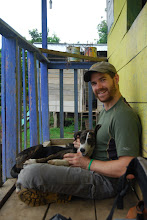Finally, we hear the call of one of our subject species calling back to us from up the trail. Without a word, Claire and I pace quickly towards the singing bird. She hands me the speakers as she pulls the microphone from a leather holster and untangles the chord from the recorder. Crouching at the trail’s edge once we get close enough to the bird, she begins recording the bird as it sings in defense of its territory. The screen of the recorder jumps erratically as it records the song, along with the toucans and cicadas screaming in the canopy above. As long as we can get close enough to the bird while it sings, it should be loud enough to differentiate the notes of the bird we want from the ambient noise of the forest, which can become deafening some days. With the last month’s dry heat, the katydids and cicadas have come out in full force, mastering the sound waves of the mid-day heat. After 830 or 9 in the morning, some places in the forest are overcome with a cacophony of this insect chorus. A few days previous, Claire and I sat waiting almost an hour for the insects to quiet down so that the birds could actually hear the speakers playing their song over the noise of the forest. Claire and I sat and talked, laughing as we had to nearly yell at each other to be heard.
Once Claire recorded enough songs for later computer analysis, she gives me a knod, and I step off the trail into the forest to search for the singing bird. In order for our recorded songs to be useful, we have to be 100% sure that each bird we record is the individual we think it is since their song is being analyzed in conjunction with blood samples we have already taken during previous visits. Sometimes it is simple. If we are lucky, the birds are drawn in close enough by the phantom intruder that we can see their identifying color bands from the trail. However, more often than not, these birds seem to have some recollection of what happened the last time they laid chase to an intruder in their territory. So, while they will sing in defense of their territory, the more often we visit their territory, the less likely they are to come close enough for us to see their leg bands.
Today, we are lucky. After changing position in the forest three times, I got back out onto the trail and ran ahead of the birds as they worked their way farther from us. I sat waiting, and each minute, their call got closer and closer, until they came hopping and flitting past me. While trying to track them through dense foliage about 2 feet off of the ground, I desperately attempted to keep them in focus and spot the color bands around their legs. At each perch these birds spend about three seconds or less standing still. So, once they move, I have just that amount of time to try and follow them, focus, see the colors on their legs, attempt to tell whether it is male of female, decide on which legs the color bands are and, if I can see really well, attempt to decide what combination the bands occur on each leg. Sometimes there are up to four bands on each bird, two per leg. It is often as simple as just spotting one or two of these bands, and knowing whether it was on the female or male. Then, I can go to the data book, and check the combination with the individual we think it is to be sure of its identity. However, once in awhile we have birds living close to each other, and while we attempt to not let it occur, every once in awhile neighbours may end up with similar color combinations, making it very important to see exactly what is on each bird’s leg. Today, I was able to see a yellow band on the right leg of the male as he perched sideways two inches off the ground for about two seconds, and about two minutes later I got the female’s combination-red on the left leg, white and silver on the right-as she perched just barely within view sideways on a sapling two feet off the ground. Thus it only took about thirty minutes of following them around in the woods today before we realized some success. This part of the research is by far the most challenging and my favorite part of this work, and it allows me to put to use skills I have been attuning since I was a child. It is not very dissimilar from the way I grew up hunting. For I must be somewhat quiet as I stalk the bird, I must get close to it and, just as I need to be accurate enough to shoot something to kill it, I have to be skilled, quick, and accurate with my binoculars to spot the bird and read the color bands on its leg. Even better, in the end I walk away successful, yet still having killed nothing.


No comments:
Post a Comment